Spatiotemporal Distribution of Soil Moisture and Salinity in the Taklimakan Desert Highway Shelterbelt
Abstract
:1. Introduction
2. Materials and Methods
2.1. Study Area

2.2. Sampling Design and Soil Analysis
2.3. Descriptive Statistical Analysis
2.4. Geostatistics Analysis
3. Results and Discussion
3.1. Descriptive Statistics of Soil Properties
| Variable | Descriptive Statistics a | DT b | ||||
|---|---|---|---|---|---|---|
| Mean | Min.–Max. | SD | CV (%) | Skewness | ||
| Moisture (%) | 1.19 | 0.00–10.00 | 2.34 | 197.0 | 2.53 | LN |
| EC (mS·cm−1) | 1.56 | 0.09–11.46 | 1.66 | 107.0 | 3.82 | LN |
| SOC (g·kg−1) | 9.46 | 1.68–27.48 | 0.32 | 49.8 | 0.58 | N |
| TN (g·kg−1) | 0.06 | 0.01–0.19 | 0.03 | 54.7 | 0.79 | N |
| TP (g·kg−1) | 0.35 | 0.17–0.70 | 0.08 | 23.9 | 0.68 | N |
| TK (g·kg−1) | 7.27 | 4.60–8.80 | 0.81 | 22.1 | −0.95 | N |
| pH | 8.32 | 7.08–9.48 | 0.53 | 6.3 | −0.15 | N |
| Sand (%) | 89.74 | 82.93–98.26 | 3.72 | 4.2 | −0.02 | N |
| Silt (%) | 10.24 | 1.74–17.07 | 3.69 | 36.1 | −0.05 | N |
| Clay (%) | 0.03 | 0.00–0.57 | 0.11 | 440.2 | 4.80 | LN |
3.2. Spatiotemporal Distribution of Soil Moisture and Salinity
3.2.1. Spatiotemporal Distribution of Soil Moisture and Salinity during the Irrigation Cycle
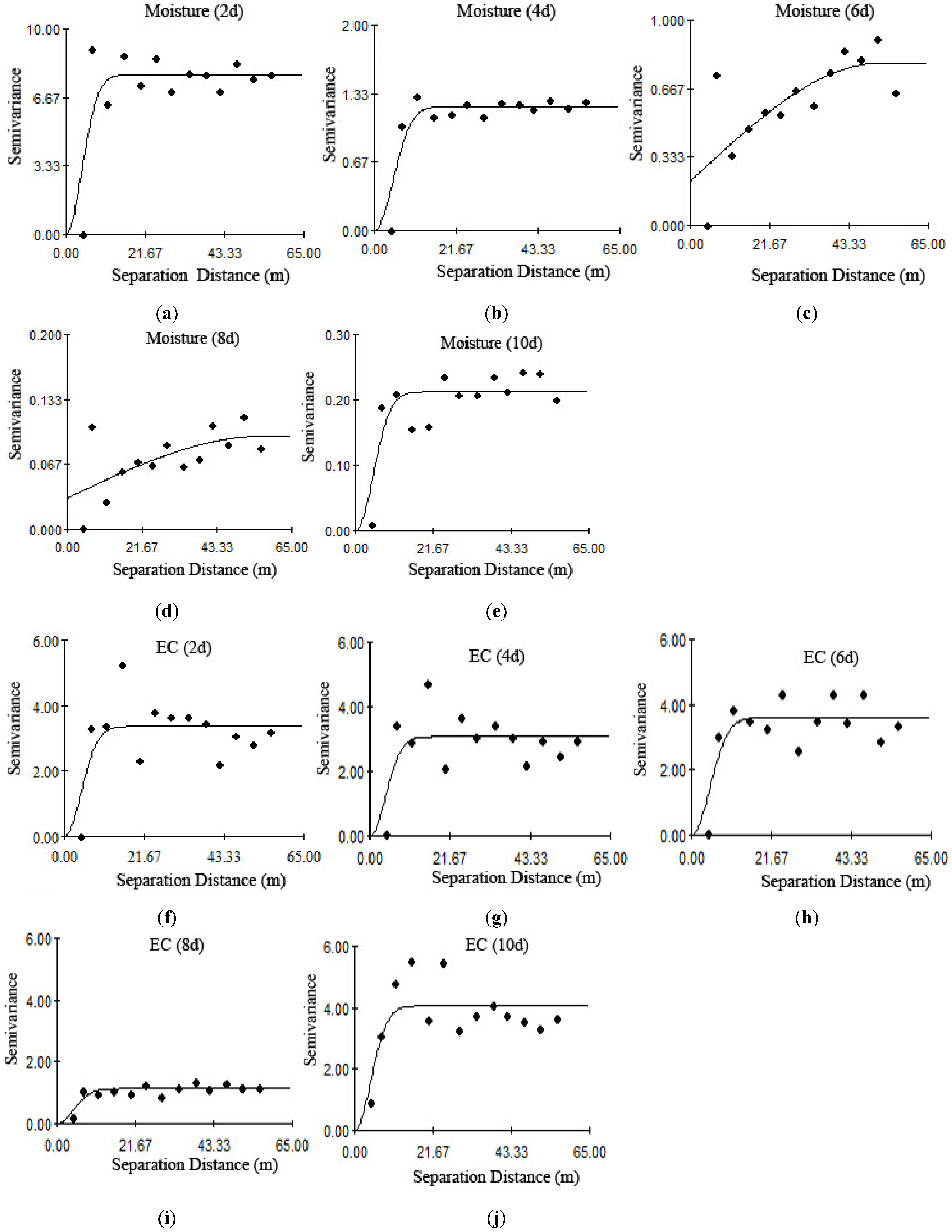
| Index | Time (d) | Mathematical Model | Range(A0)/m | Nugget/C0 | Sill/(C0 + C) | C0/(C0 + C)% | R2 |
|---|---|---|---|---|---|---|---|
| Moisture | 2 | Gaussian | 6.10 | 0.01 | 7.77 | 0.13 | 0.63 |
| 4 | Gaussian | 6.90 | 0.01 | 1.21 | 0.83 | 0.83 | |
| 6 | Spherical | 51.90 | 0.22 | 0.79 | 27.31 | 0.56 | |
| 8 | Spherical | 57.00 | 0.03 | 0.10 | 3.22 | 0.38 | |
| 10 | Gaussian | 6.80 | 0.00 | 0.21 | 0.47 | 0.68 | |
| Salinity | 2 | Gaussian | 6.40 | 0.01 | 3.36 | 0.21 | 0.48 |
| 4 | Gaussian | 6.00 | 0.00 | 3.07 | 0.03 | 0.45 | |
| 6 | Gaussian | 6.90 | 0.01 | 3.60 | 0.28 | 0.67 | |
| 8 | Gaussian | 6.40 | 0.00 | 1.13 | 0.08 | 0.67 | |
| 10 | Gaussian | 6.10 | 0.01 | 4.06 | 0.25 | 0.56 |
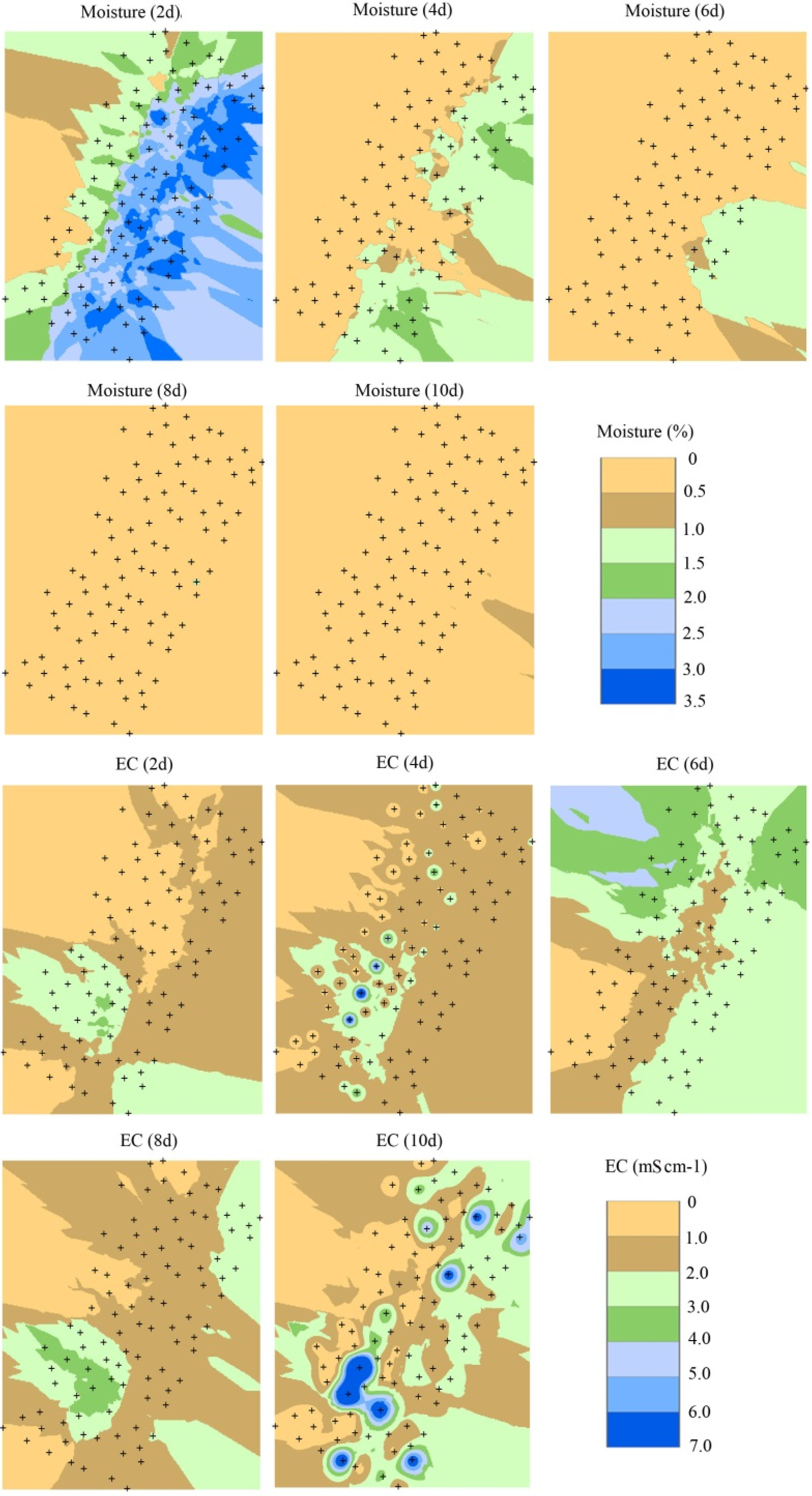

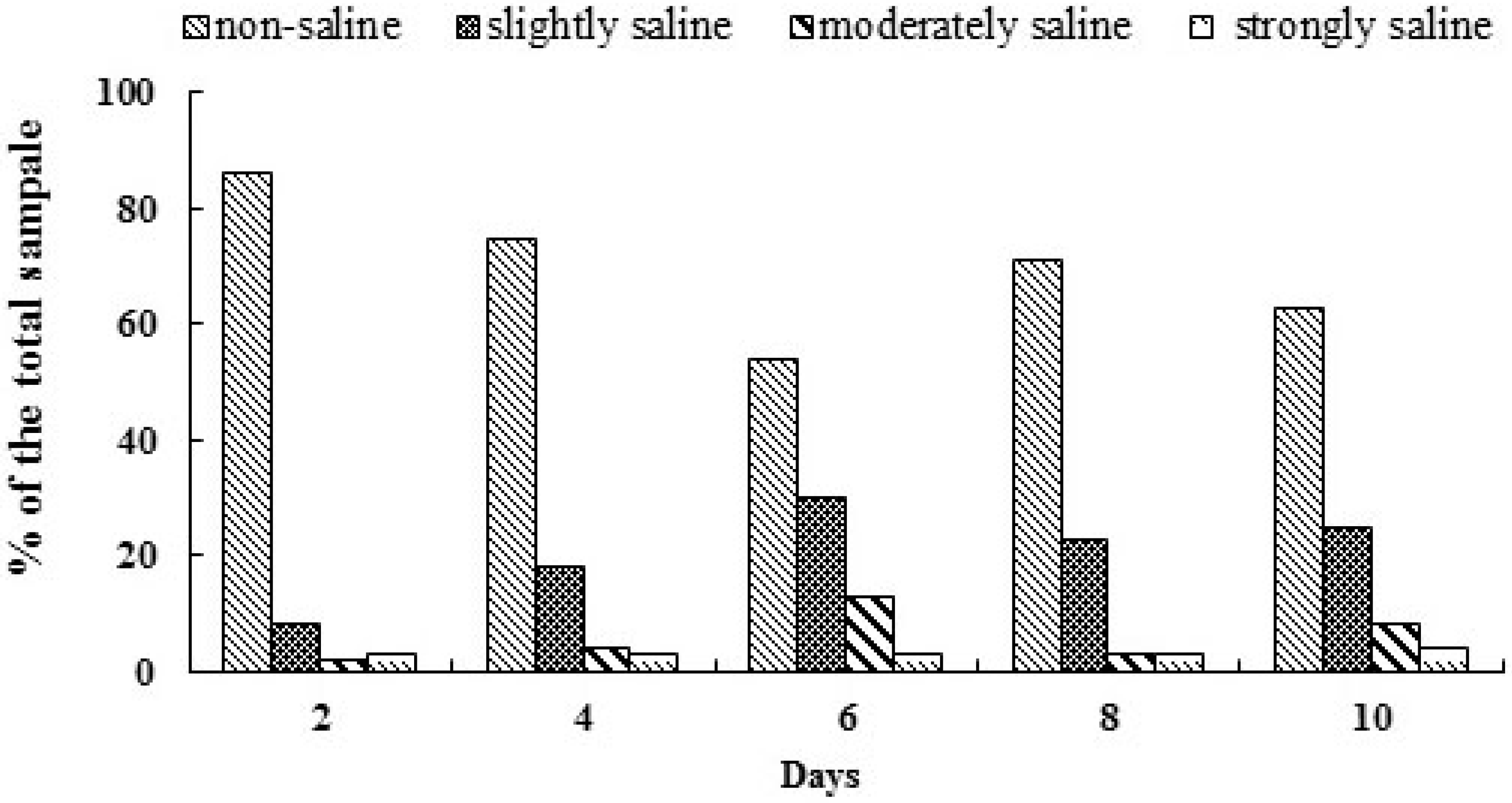
3.2.2. Spatiotemporal Distribution of Soil Moisture and Salinity in Different Seasons
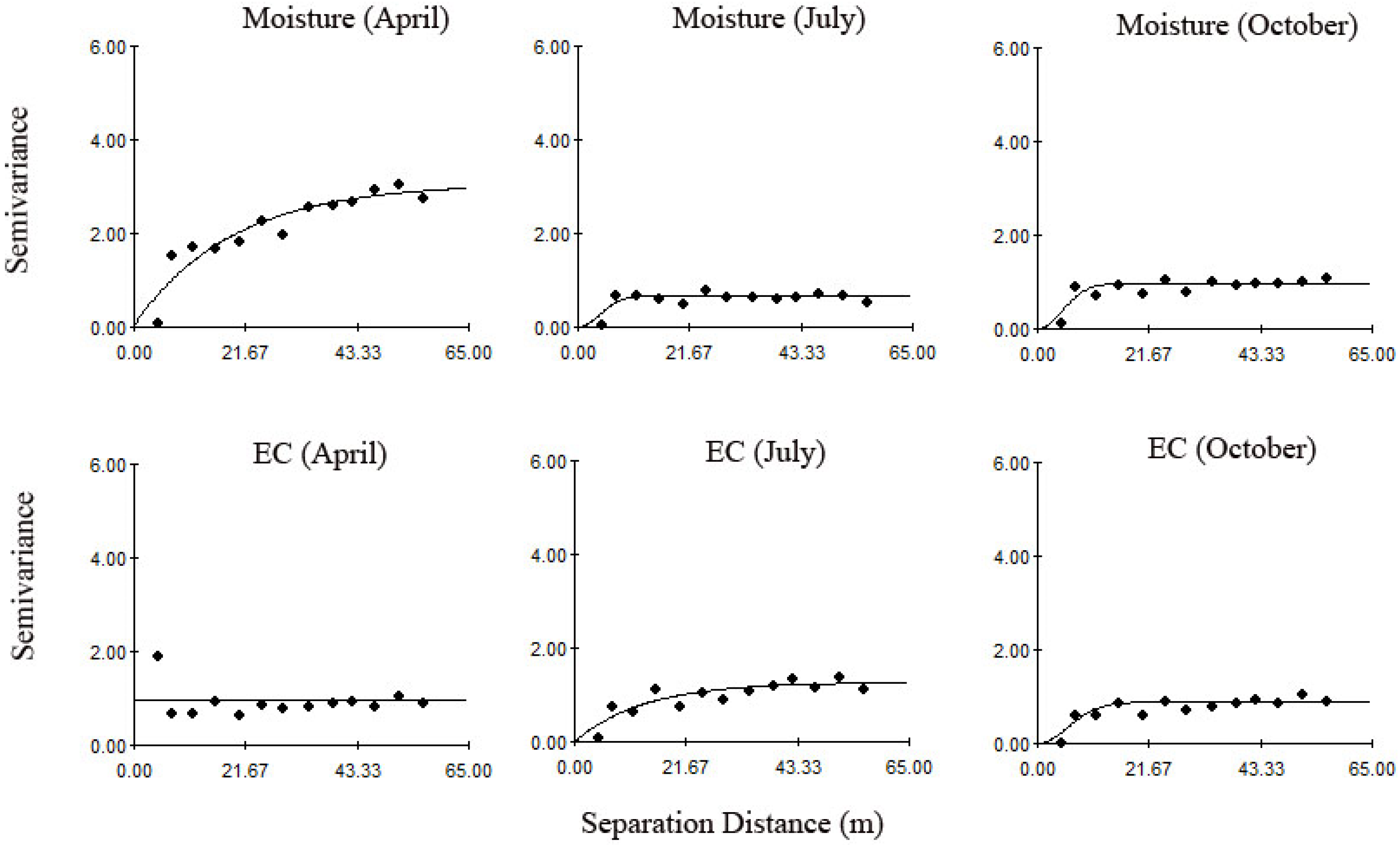
| Index | Month | Mathematical Model | Range(A0)/m | Nugget/C0 | Sill/(C0 + C) | C0/(C0 + C)% | R2 |
|---|---|---|---|---|---|---|---|
| Moisture | April | Exponential | 57.3 | 0.05 | 3.07 | 1.60 | 0.86 |
| July | Spherical | 57.00 | 0.03 | 0.10 | 3.22 | 0.38 | |
| October | Exponential | 33.90 | 0.00 | 0.30 | 0.03 | 0.72 | |
| Salinity | April | linear | 55.83 | 0.95 | 0. 95 | 100 | 0.00 |
| July | Exponential | 13.40 | 0.00 | 1.27 | 0.08 | 0.75 | |
| October | Gaussian | 52.30 | 2.43 | 5.88 | 41.33 | 0.86 |
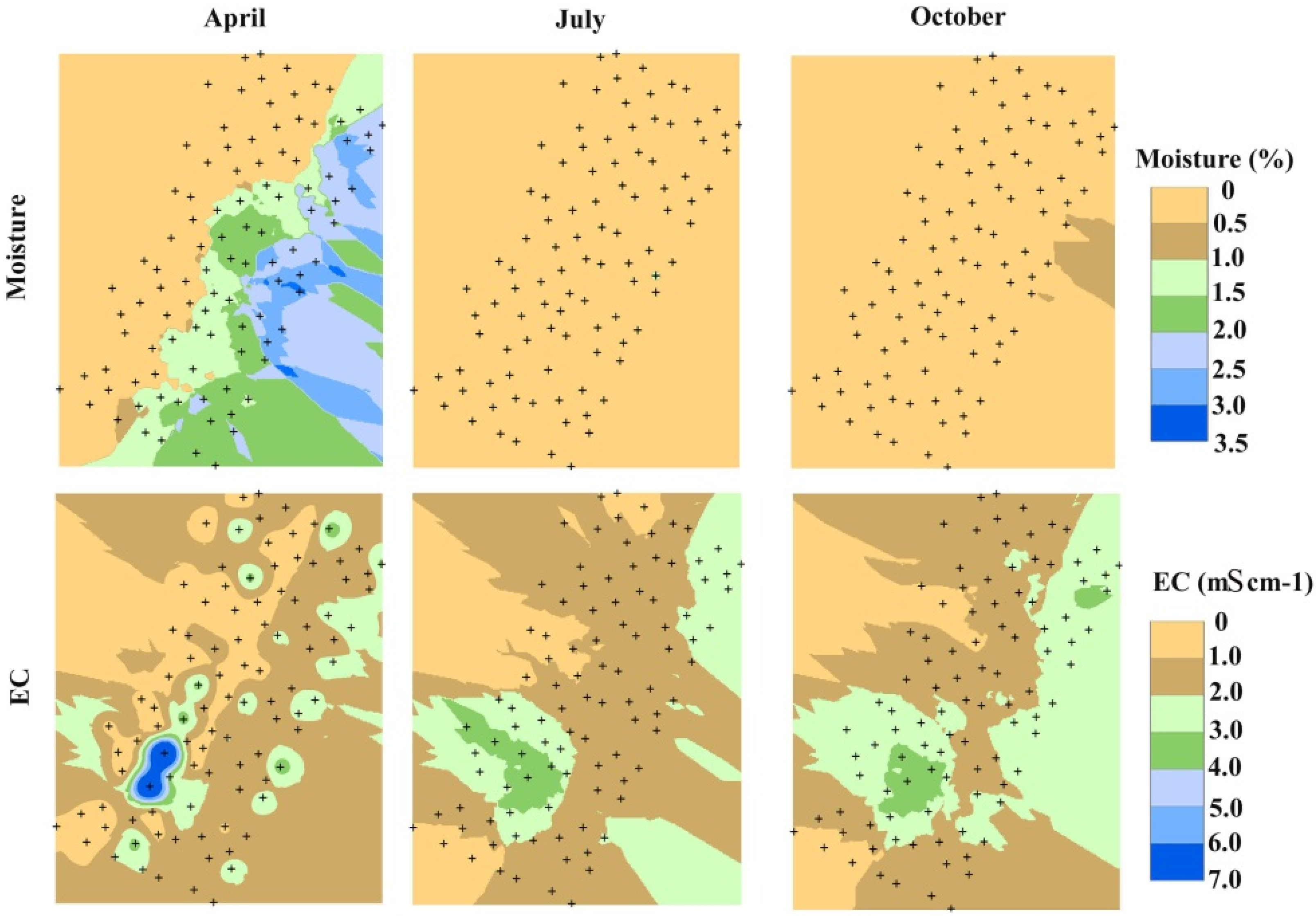

3.3. Correlation between Selected Parameters
| Index | Moisture (%) | EC (ms·cm−1) | SOC (g·kg−1) | TN (g·kg−1) | TP (g·kg−1) | TK (g·kg−1) | pH | Sand (%) | Silt (%) | Clay (%) | Terrain (m) |
|---|---|---|---|---|---|---|---|---|---|---|---|
| Moisture (%) | 1 | ||||||||||
| EC (mS·cm−1) | 0.12 | 1 | |||||||||
| SOC (g·kg−1) | 0.11 | 0.10 | 1 | ||||||||
| TN (g·kg−1) | 0.34 ** | 0.36 ** | 0.10 | 1 | |||||||
| TP (g·kg−1) | −0.06 | 0.22 * | 0.10 | 0.21 * | 1 | ||||||
| TK (g·kg−1) | 0.13 | −0.09 | 0.07 | 0.08 | −0.31 ** | 1 | |||||
| pH | −0.28 ** | −0.19 | −0.04 | −0.31 ** | −0.06 | 0.25 * | 1 | ||||
| Sand (%) | −0.23 * | −0.40 ** | −0.39 ** | −0.40 ** | −0.14 | −0.15 | −0.22 * | 1 | |||
| Silt (%) | 0.23 * | 0.41 ** | 0.38 ** | 0.40 ** | 0.15 | 0.15 | 0.22* | −1.00 ** | 1 | ||
| Clay (%) | −0.11 | −0.20 | 0.19 | −0.05 | −0.22 * | −0.02 | 0.06 | −0.27 ** | 0.24 * | 1 | |
| Terrain (m) | −0.03 | −0.05 | 0.06 | −0.04 | −0.19 | 0.12 | 0.04 | 0.21 * | −0.22 * | 0.06 | 1 |
4. Conclusions
Acknowledgments
Author Contributions
Conflicts of Interest
References
- Chartzoulakis, K.S. Salinity and olive: Growth, salt tolerance, photosynthesis and yield. Agric. Water Manag. 2005, 78, 108–121. [Google Scholar] [CrossRef]
- Beltran, J.M. Irrigation with saline water: Benefits and environmental impact. Agric. Water Manag. 1999, 40, 183–194. [Google Scholar] [CrossRef]
- Feikema, P.M.; Morris, J.D.; Connell, L.D. The water balance and water sources of a eucalyptus plantation over shallow saline groundwater. Plant Soil 2010, 332, 429–449. [Google Scholar] [CrossRef]
- Lei, J.Q.; Li, S.Y.; Jin, Z.Z.; Fan, J.L.; Wang, H.F.; Fan, D.D.; Zhou, H.W.; Gu, F.; Qiu, Y.; Xu, B. Comprehensive eco-environmental effects of the shelter-forest ecological engineering along the Tarim Desert Highway. Chin. Sci. Bull. 2009, 53, 190–202. [Google Scholar] [CrossRef]
- Li, B.; Xu, X.; Lei, J.; Qiu, Y.; Xu, B.; Zhou, H.; Wang, Q.; Wang, B.; Su, W. Site type classification for the shelter-forest ecological project along the Tarim Desert Highway. Chin. Sci. Bull. 2009, 53, 31–40. [Google Scholar] [CrossRef]
- Zhang, J.; Xu, X.; Lei, J.; Sun, S.; Fan, J.; Li, S.; Gu, F.; Qiu, Y.; Xu, B. The salt accumulation at the shifting aeolian sandy soil surface with high salinity groundwater drip irrigation in the hinterland of the Taklimakan Desert. Chin. Sci. Bull. 2009, 53, 63–70. [Google Scholar] [CrossRef]
- Homer-Dixon, T.F. Environmental scarcities and violent conflict: Evidence from cases. Int. Secur. 1994, 19, 5–40. [Google Scholar] [CrossRef]
- Wang, Y.; Xiao, D.; Li, Y.; Li, X. Soil salinity evolution and its relationship with dynamics of groundwater in the oasis of inland river basins: Case study from the Fubei Region of Xinjiang Province, China. Environ. Monit. Assess. 2008, 140, 291–302. [Google Scholar] [CrossRef] [PubMed]
- Salvati, L.; Ferrara, C. The local-scale impact of soil salinization on the socioeconomic context: An exploratory analysis in Italy. Catena 2015, 127, 312–322. [Google Scholar] [CrossRef]
- Karlen, D.L.; Tomer, M.D.; Neppel, J.; Cambardella, C.A. A preliminary watershed scale soil quality assessment in north central Iowa, USA. Soil Tillage Res. 2008, 99, 291–299. [Google Scholar] [CrossRef]
- Talaat, N.B.; Ghoniem, A.E.; Abdelhamid, M.T.; Shawky, B.T. Effective microorganisms improve growth performance, alter nutrients acquisition and induce compatible solutes accumulation in common bean (phaseolus vulgaris l.) plants subjected to salinity stress. Plant Growth Regul. 2014, 75, 281–295. [Google Scholar] [CrossRef]
- Garg, N.; Singla, P. Naringenin- and Funneliformis mosseae-mediated alterations in redox state synchronize antioxidant network to alleviate oxidative stress in Cicer arietinum L. Genotypes under salt stress. J. Plant Growth Regul. 2015, 1–16. [Google Scholar] [CrossRef]
- Zhang, H.J.; Dong, H.Z.; Li, W.J.; Zhang, D.M. Effects of soil salinity and plant density on yield and leaf senescence of field-grown cotton. J. Agron. Crop Sci. 2012, 198, 27–37. [Google Scholar] [CrossRef]
- Shannon, M.C.; Grieve, C.M. Tolerance of vegetable crops to salinity. Sci. Hortic. 1999, 78, 5–38. [Google Scholar] [CrossRef]
- Li, C.; Lei, J.; Zhao, Y.; Xu, X.; Li, S. Effect of saline water irrigation on soil development and plant growth in the taklimakan desert highway shelterbelt. Soil Tillage Res. 2015, 146, 99–107. [Google Scholar] [CrossRef]
- Sumner, M.; Rengasamy, P.; Naidu, R. Sodic soils: A reappraisal. In Sodic Soil: Distribution, Management and Environmental Consequences; Sumner, M., Naidu, R., Eds.; Oxford University Press: New York, NY, USA, 1998; pp. 3–17. [Google Scholar]
- Li, C.J.; Li, Y.; Jian, M.A.; Fan, L.L.; Wang, Q.X. Spatial heterogeneity of soil chemical properties between haloxylon persicum and haloxylon ammodendron populations. J. Arid Land 2010, 2, 257–265. [Google Scholar]
- Gu, F.X.W.; Wen, Q.K.; Pan, B.R.; Hu, Y.L.; Xu, H.L. Research on soil enzyme activities of aeolian soil under artificial plantation in Taklimakan Desert heartland. J. Desert Res. 2000, 20, 293–297. [Google Scholar]
- Stoyan, H.; De-Polli, H.; Böhm, S.; Robertson, G.P.; Paul, E.A. Spatial heterogeneity of soil respiration and related properties at the plant scale. Plant Soil 2000, 222, 203–214. [Google Scholar] [CrossRef]
- Hu, W.; Shao, M.; Han, F.; Klaus, R.; Jing, T. Watershed scale temporal stability of soil water content. Geoderma 2010, 158, 181–198. [Google Scholar] [CrossRef]
- Wilczek, A.; Szypłowska, A.; Skierucha, W.; Cieśla, J.; Pichler, V.; Janik, G. Determination of soil pore water salinity using an FDR sensor working at various frequencies up to 500 MHz. Sensors (Basel) 2012, 12, 10890–10905. [Google Scholar] [CrossRef] [PubMed]
- Skierucha, W.; Wilczek, A.; Szypłowska, A.; Sławiński, C.; Lamorski, K. A TDR-based soil moisture monitoring system with simultaneous measurement of soil temperature and electrical conductivity. Sensors (Basel) 2012, 12, 13545–13566. [Google Scholar] [CrossRef] [PubMed]
- Douaik, A.; van Meirvenne, M.; Tóth, T. Statistical methods for evaluating soil salinity spatial and temporal variability. Soil Sci. Soc. Am. J. 2007, 71, 1629–1635. [Google Scholar] [CrossRef]
- Schneider, K.; Huisman, J.A.; Breuer, L.; Frede, H.G. Ambiguous effects of grazing intensity on surface soil moisture: A geostatistical case study from a steppe environment in Inner Mongolia, PR China. J. Arid Environ. 2008, 72, 1305–1319. [Google Scholar] [CrossRef]
- Eigenberg, R.A.; Doran, J.W.; Nienaber, J.A.; Ferguson, R.B.; Woodbury, B.L. Electrical conductivity monitoring of soil condition and available N with animal manure and a cover crop. Agric. Ecosyst. Environ. 2002, 88, 183–193. [Google Scholar] [CrossRef]
- Zheng, Z.; Zhang, F.; Ma, F.; Chai, X.; Zhu, Z.; Shi, J.; Zhang, S. Spatiotemporal changes in soil salinity in a drip-irrigated field. Geoderma 2009, 149, 243–248. [Google Scholar] [CrossRef]
- Corwin, D.L.; Lesch, S.M. Apparent soil electrical conductivity measurements in agriculture. Comput. Electron. Agric. 2005, 46, 11–43. [Google Scholar] [CrossRef]
- Nelson, D.W.; Sommers, L.E. Total carbon, organic carbon, and organic matter. Methods soil Anal. 1996, 3, 961–1010. [Google Scholar]
- Egner, H.; Riehm, H.; Domingo, W.E. Untersuchungen über die chemische Bodenanalyse als Grundlage für die Beurteilung des Nährstoffzustandes der Böden. II. Chemische Extraktionsmethoden zur Phosphor-und Kaliumbestimmung. Lantbrukshogskolans Unnaler 1960, 26, 199–215. [Google Scholar]
- Day, P.R. Particle fractionation and particle-size distribution. Methods Soil Anal. 1965, 9, 548–549. [Google Scholar]
- Western, A.W.; Blöschl, G.; Grayson, R.B. Geostatistical characterisation of soil moisture patterns in the Tarrawarra catchment. J. Hydrol. 1998, 205, 20–37. [Google Scholar] [CrossRef]
- Augustine, D.J.; Frank, D.A. Effects of migratory grazers on spatial heterogeneity of soil nitrogen properties in a grassland ecosystem. Ecology 2001, 82, 3149–3162. [Google Scholar] [CrossRef]
- Goovaerts, P. Geostatistical tools for characterizing the spatial variability of microbiological and physico-chemical soil properties. Biol. Fertil. Soils 1998, 27, 315–334. [Google Scholar] [CrossRef]
- Hu, K.; Li, H.; Li, B.; Huang, Y. Spatial and temporal patterns of soil organic matter in the urban–rural transition zone of Beijing. Geoderma 2007, 141, 302–310. [Google Scholar] [CrossRef]
- Zhang, J.G.; Chen, H.S.; Su, Y.R. Spatial variability and patterns of surface soil moisture in a field plot of karst area in southwest China. Plant Soil Environ. 2011, 57, 409–417. [Google Scholar]
- Corwin, D.L.; Lesch, S.M.; Oster, J.D.; Kaffka, S.R. Monitoring management-induced spatio–temporal changes in soil quality through soil sampling directed by apparent electrical conductivity. Geoderma 2006, 131, 369–387. [Google Scholar] [CrossRef]
- Zhang, Z.; Hu, B.; Hu, G. Spatial heterogeneity of soil chemical properties in a subtropical karst forest, southwest China. Sci. World J. 2014, 2014, 9. [Google Scholar] [CrossRef] [PubMed]
- McBratney, A.B.; Minasny, B.; Cattle, S.R. From pedotransfer functions to soil inference systems. Geoderma 2002, 109, 41–73. [Google Scholar] [CrossRef]
- Liu, Z.P.; Shao, M.A.; Wang, Y.Q. Spatial patterns of soil total nitrogen and soil total phosphorus across the entire loess plateau region of China. Geoderma 2013, 197, 67–78. [Google Scholar] [CrossRef]
- Zhao, Y.; Peth, S.; Wang, X.Y.; Lin, H.; Horn, R. Controls of surface soil moisture spatial patterns and their temporal stability in a semi-arid steppe. Hydrol. Processes 2010, 24, 2507–2519. [Google Scholar] [CrossRef]
- Abrol, I.P.; Yadav, J.S.P.; Massoud, F.I. Salt-affected soils and their managemen. In FAO Soils Bull; United Nations: Rome, Italy, 1988. [Google Scholar]
- Wang, X.J.; Xu, X.W.; Lei, J.Q. Spatiotemporal distribution of salt crust in a shelter-forest belt under drip-irrigation with salt water. Arid Zone Res. 2006, 23, 399–404. [Google Scholar]
- Pereira, L.S.; Oweis, T.; Zairi, A. Irrigation management under water scarcity. Agricultural water management. Agric. Water Manag. 2002, 57, 175–206. [Google Scholar] [CrossRef]
- Li, C.; Li, Y.; Ma, J. Spatial heterogeneity of soil chemical properties at finescales induced by haloxylon ammodendron (chenopodiaceae) plants in a sandy desert. Ecol. Res. 2011, 26, 385–394. [Google Scholar] [CrossRef]
- Brantley, S.L. Understanding soil time. Science 2008, 321, 1454–1455. [Google Scholar] [CrossRef] [PubMed]
- Wang, G.; Garcia, D.; Liu, Y.; de Jeu, R.; Johannes Dolman, A. A three-dimensional gap filling method for large geophysical datasets: Application to global satellite soil moisture observations. Environ. Model. Softw. 2012, 30, 139–142. [Google Scholar] [CrossRef]
- Lowery, B.; Swan, J.; Schumacher, T.; Jones, A. Physical properties of selected soils by erosion class. J. Soil Water Conserv. 1995, 50, 306–311. [Google Scholar]
- Zhao, H.L.; Zhou, R.L.; Zhang, T.H.; Zhao, X.Y. Effects of desertification on soil and crop growth properties in Horqin sandy cropland of Inner Mongolia, north China. Soil Tillage Res. 2006, 87, 175–185. [Google Scholar] [CrossRef]
© 2015 by the authors; licensee MDPI, Basel, Switzerland. This article is an open access article distributed under the terms and conditions of the Creative Commons Attribution license (http://creativecommons.org/licenses/by/4.0/).
Share and Cite
Huang, Y.; Wang, Y.; Zhao, Y.; Xu, X.; Zhang, J.; Li, C. Spatiotemporal Distribution of Soil Moisture and Salinity in the Taklimakan Desert Highway Shelterbelt. Water 2015, 7, 4343-4361. https://doi.org/10.3390/w7084343
Huang Y, Wang Y, Zhao Y, Xu X, Zhang J, Li C. Spatiotemporal Distribution of Soil Moisture and Salinity in the Taklimakan Desert Highway Shelterbelt. Water. 2015; 7(8):4343-4361. https://doi.org/10.3390/w7084343
Chicago/Turabian StyleHuang, Yuan, Yongdong Wang, Ying Zhao, Xinwen Xu, Jianguo Zhang, and Congjuan Li. 2015. "Spatiotemporal Distribution of Soil Moisture and Salinity in the Taklimakan Desert Highway Shelterbelt" Water 7, no. 8: 4343-4361. https://doi.org/10.3390/w7084343






